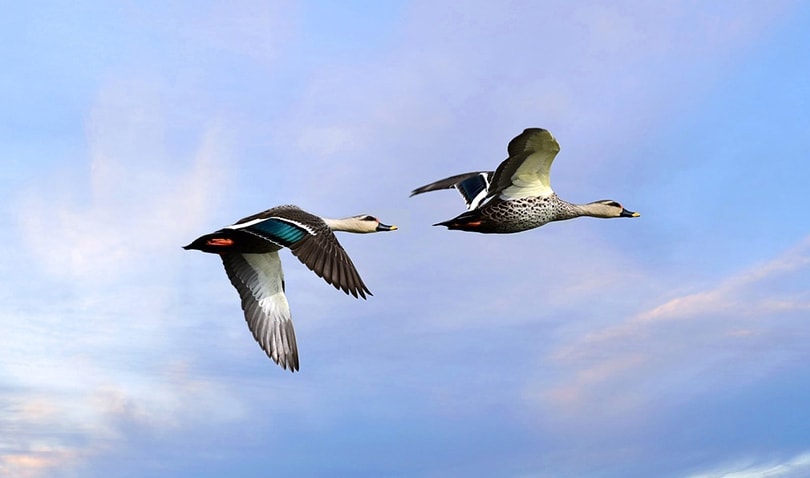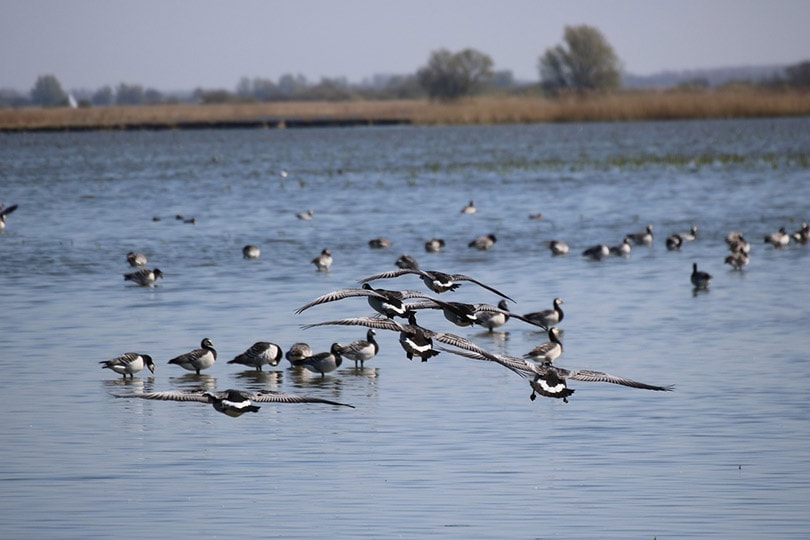Do Ducks Migrate? Where Do They Go?
Last Updated on

Birds notoriously fly south for the winter—depending on where you live on the map. Maybe they leave your area in search of greener lands—or perhaps they come to visit you instead. Either way, these waterfowl travel long distances to maintain survival in harsh winter months.
While each duck species is a little different—generally speaking, almost all ducks migrate. But there are some exceptions and variations in this. Let’s take a closer look.
Why Do Ducks Migrate?
Ducks migrate during months where their food supply is short. They travel to warmer climates where the diet and habitat options are vast. Like other birds, ducks have a naturally embedded sense of weather changes.
They are aware of when the season starts to turn and organically pick the right time to move along for the season. Migration is a hardwired aspect of their makeup and is necessary for survival.
As migratory behavior begins in the springtime, the increasing daylight triggers internal hormone responses accordingly. Ducks follow a pattern of accumulating body fat stores, migrating to a better climate, breeding, molting—and so the cycle repeats.
In the fall, ducks enter a period known as Zugunruhe, which is migratory restlessness. They start to prepare for the upcoming migration for the winter by fattening up those reserves and preparing for the perfect moment for transition.

Migration Schedules for Ducks
Migration is a highly predictable behavior but one that does not operate on a precise schedule. As a good example, since North American seasonal changes are often steady, the exact day different duck species migrate is yet to be determined.
Migration is influenced by weather—so, the process is very sensitive to temperature, precipitation, and wind. For instance, if there is a cold front, it could greatly influence when the flock of birds takes off.
Waterfowl hunters are particularly skilled at knowing when these birds will show up by looking at natural environmental factors each year.
- You may also like: Where Do Ducks Sleep?
How Far Do Ducks Fly?
The flight of ducks can drastically vary depending on the breed. Each species will have its own migratory schedule to travel to different areas at various distances. However, some duck species travel just over 100 miles while others travel thousands during migration.
Here are a few different duck species with examples for reference:
| Type of Duck | Spring Location | Fall Location | Average Miles | |
| Mallard | Dabbling | Coastal Northern
North America/Eurasia |
Coastal Southern North America/ Eurasia | 730 |
| Harlequin Duck | Diving | Northwestern North America | Coastal Northwestern North America | 800 |
| Ruddy Duck | Stiff-tailed ducks | North America | Southern North and South America | 1,000 |
| Bufflehead Duck | Sea duck | Northern North America | Southern North America, Coastal North America | 1,200 |
| Black Brant | Nigricans | Alaska | Baja, California | 3,000 |
Which Duck Species Do Not Migrate?
Migration can be interesting, even within the same species. For instance, the ruddy duck mentioned in the chart above often migrates, but that isn’t always the case. Those ducks who live in very tropical locations might have no need, as they have year-round access to food.
This same concept applies to other duck species. If ducks are fortunate enough to live in a suitable, abundant, environmentally sound area year-round, they will have no reason to travel.
Farm duck species do not migrate for a few reasons. First, their bodies are often too heavy to fly (most are lucky to glide.) They were bred this way for egg and meat production in the farming industry.
Next, they have shelter and food supplied for them during the winter months. So, they aren’t a victim to circumstance, stuck in unbearable temperatures with no protection. They are well suited for captivity in this way.

What Are Molt Migrations?
Molt migration is an interesting topic defined by Finn Salomonsen as “birds moving from the breeding grounds to a special molting area where they can rapidly replace their flight feathers at a low predation risk before resuming their migration to the winter quarters.”
This means that after the birds successfully reproduce, they flee to an area where they are well protected from other predators so they can regain their strength and regrow lost feathers in peace. Consider it a short vacation or recovery window.
Molt migrations can be up to an astonishing 800 miles from the breeding grounds.
Feeding Ducks Before Migration
What is pretty cool is that ducks benefit from particular foods before migration takes place. As you can imagine, traveling several hundred miles in one flight burns a lot of calories. Many ducks are quite depleted after such an extensive journey.
If you live or visit an area that has ducks in the spring and fall months, you can help them store up their fat reserves. This can be your way of contributing to the long haul ahead.
- Cracked corn
- Wheat
- Barley
- Oats
- Cooked rice
- Birdseed
- Peas
- Leafy greens
- Mealworms (dried or live)
- Bread
- Sugary desserts
- Crackers
- Chips
Especially stay away from any item with added sugar, salt, or other seasonings.
Final Thoughts
So, yes, most ducks migrate to warmer climates with readily available food sources when seasons change. This behavior is a survival instinct that ensures the continuance of the species. Ducks can fly great distances during migration, but some get lucky enough to stay year-round.
If you want to help local ducks this season, you can feed them a nutritious snack so they can store up fat reserves before their next journey.
Featured Image Credit: SajeevBhaskaran, Pixabay
About the Author Ashley Bates
Ashley Bates is animal writer and enthusiast who is currently studying the art of animal therapy. A mother to four human children— and 23 furry and feathery kids, too – Ashley volunteers at local shelters, advocates for animal well-being, and rescues every creature she finds. Ashley's mission is to create awareness and education about animals of all shapes and sizes to promote proper care and respect.
Related Articles:
How to Clean a Refractor Telescope: Step-by-Step Guide
How to Clean a Telescope Eyepiece: Step-by-Step Guide
How to Clean a Rifle Scope: 8 Expert Tips
Monocular vs Telescope: Differences Explained (With Pictures)
What Is a Monocular Used For? 8 Common Functions
How to Clean a Telescope Mirror: 8 Expert Tips
Brightfield vs Phase Contrast Microscopy: The Differences Explained
SkyCamHD Drone Review: Pros, Cons, FAQ, & Verdict
